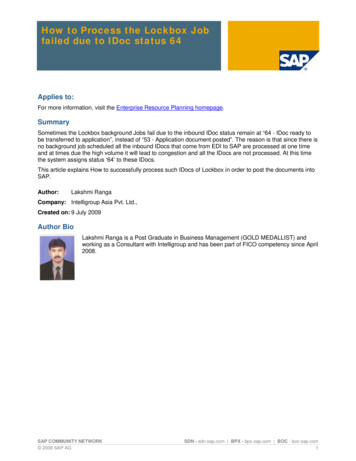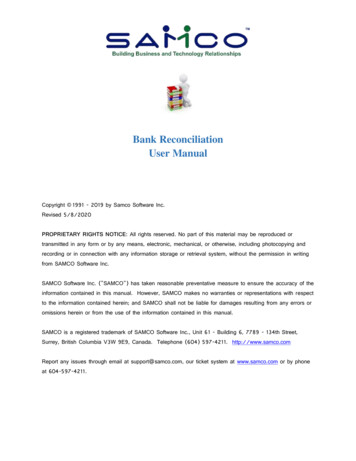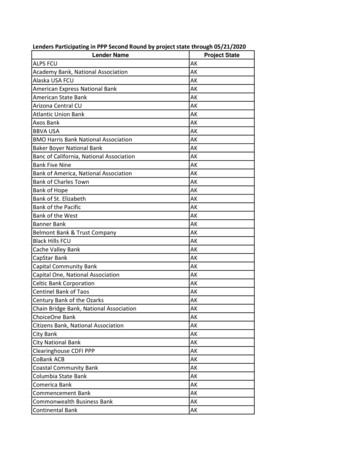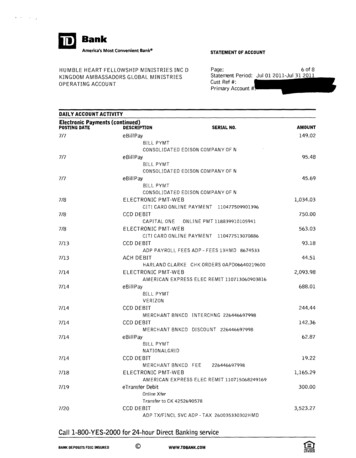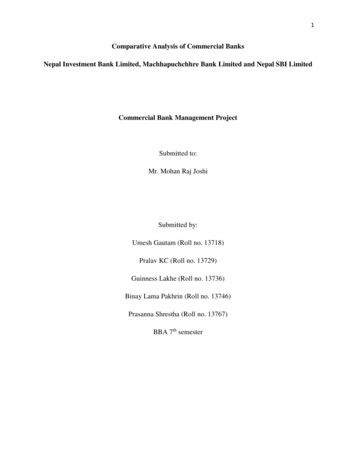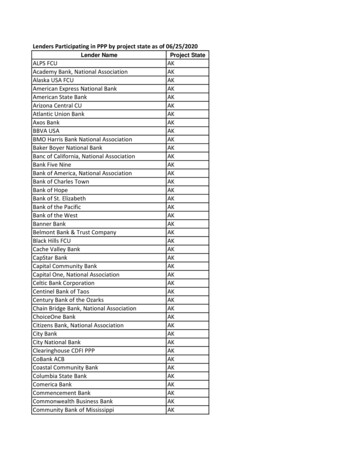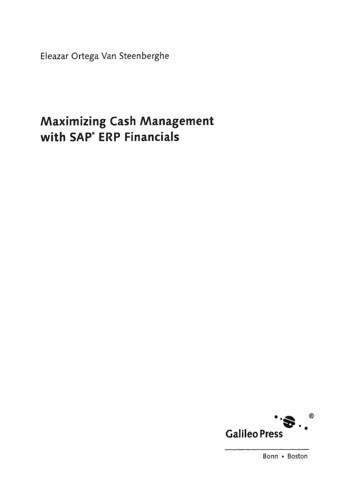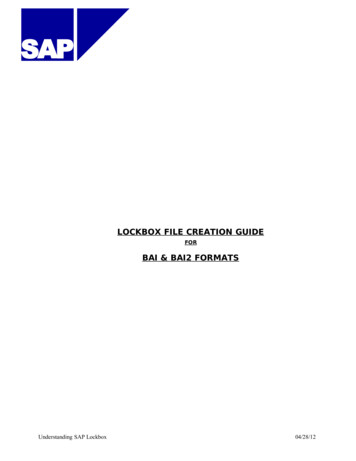
Transcription
Electronic BankStatement & Lockboxin SAP ERPLennart B. UllmannClaus Wild
TABLE OF CONTENTSTable of ContentsForeword1 Importing and Processing BankStatements in the Standard SAP System7111.1Settings for the Data Import in EhP6131.2Processing Collective Credit Memos241.3Processing Financial Information withSWIFT MT942281.4Processing XML Bank Statements331.5Return Debits in the Electronic BankStatement42Summary481.62 Postprocessing Bank Statements in theStandard SAP System492.1Postprocessing Transaction FEBAN512.2Definition of PostprocessingTransactions in EhP654Postprocessing TransactionFEB BSPROC in EhP660Summary762.32.43 Integration of Payment Advices in theStandard SAP System793.1Use of Payment Advices in SAP813.2Payment Advices in Cash Management933
TABLE OF CONTENTS3.3Payment Advices in the Electronic BankStatement953.4Enhancement Options from EhP5973.5Summary4 Lockbox overview4.1106109What is a lockbox and how does itwork?1094.2Business process overview1104.3Advantages of lockbox1114.4Lockbox vs. Electronic Bank Statement1124.5Summary1135 Lockbox process in SAP1155.1Main lockbox program RFEBLB001165.2Main lockbox program RFEBLB301215.3Payment advices as part of the lockboxprocess1235.4Lockbox postprocess1245.5Updating customer bank information1315.6Summary1326 Lockbox configuration1336.1Define control parameters1336.2Define posting data1386.3Define lockboxes for house banks1416.4Summary1437 Lockbox file record formats7.14Difference between BAI / BAI2 formatsand EDI ANSI 823145145
TABLE OF CONTENTS7.2BAI / BAI2 file format1467.3Summary1668 Customer master record8.1Summary9 Electronic bank statements in NorthAmerica (Appendix)9.1167169171BAI2 file format for electronic bankstatements1719.2BAI preprocessor1779.3Common business transaction codes(BTC)178Interpretation algorithm for outgoingchecks179Summary1819.49.510 Useful programs18310.1 Lockbox file creating programs18310.2 RFEBKA96—Delete buffer18710.3 Summary18911 Quick Reference Guide19111.1 Transaction codes19111.2 Reports19211.3 Tables (Maintenance)193A The Authors198B Index201C Disclaimer2045
2 Postprocessing BankStatements in the StandardSAP SystemThe next step after importing the electronic bankstatements in SAP is to assign and post incorrectbank statement items. This chapter looks at the functions for postprocessing bank statements in detail. Inparticular, it examines the enhanced options available in Enhancement Package 6 (EhP6).The rules and elements defined in Customizing for theautomatic posting of bank statements, as well as optional user exits and search patterns, rarely achieve a posting quota that can be managed without additional postprocessing of the bank statement information. In thestandard SAP system, there are two options available forfurther postprocessing of electronic bank statements:you can use the batch input processing functions or postincorrect documents directly via transactions FEBAN orFEBA. With the introduction of SAP Release 4.7 Enterprise, the existing postprocessing transaction FEBA wassupplemented with the revised version FEBAN. Thefocus was on achieving the most productive and flexibleprocessing of incorrect documents.You decide which option to select for postprocessing atthe time of the import in program RFEBKA00.The standard program for electronic bank statementprocessing offers you the two options mentioned above:49
POSTPROCESSING BANK STATEMENTS IN THE STANDARD SAP SYSTEM Post immediately (call transaction) Create batch input sessionsUsing the POST IMMEDIATELY function, you can use transaction FEBAN to postprocess the line items that werenot posted and assigned automatically. With this procedure, during the import, each line of the bank statementis interpreted immediately and saved in the bank datamemory with a document number. The status of a document or a posting (general and subledger) is visible forthe clerk immediately.Information: Classifying Transaction FEBANPostprocessing transaction FEBAN ispart of the Financials Extension (EA-FIN)Business Function which must first beactivated via the SAP Customizing Implementation Guide. The enhanced functions forbank statement processing are only available afterthis activation.If postprocessing via this enhancement is not desired,you can also use the predecessor transaction FEBA.However, the call of this transaction must also be ensured in advance.To do this, use transaction SM31 to call up viewV T100C. Via the MAINTAIN icon, you can access thechange mode for the table. Choose NEW FEBA as thearea. Create message 001, as shown in Figure 2.1:Transaction FEBAN not required, FEBA is starting.50
POSTPROCESSING BANK STATEMENTS IN THE STANDARD SAP SYSTEMFigure 2.1: Message control for bank statement postprocessingThe message ensures that you can postprocess thebank statements with transaction FEBA or FEBAN withan activated EA-FIN package. If the bank statements arenot processed via the option POST IMMEDIATELY, and youcreate batch input sessions instead, you cannot use oneof these two transactions.2.1Postprocessing Transaction FEBANIn contrast to FEBA, transaction FEBAN appears clearerand offers more information for postprocessing documents. Numerous small enhancements also ensure acertain degree of flexibility and enable adjustments toindividual requirements for bank statement posting. Asan example, the following points aim to show how youcan adapt the postprocessing further to your requirements.In the standard SAP system, the following are availablefor users for further processing of bank statements: Tree display Grid display (table display)51
POSTPROCESSING BANK STATEMENTS IN THE STANDARD SAP SYSTEMIn the standard system, the bank statements are generally selected via the tree display. However, the standardformat is rather spartan and provides insufficient information for the selected house bank.Therefore, if the tree display is not required here, youcan use Note 1741730 to define the default display (treeor grid display) via the user parameter FEBAN DEFDISPLAY. Furthermore, you can replace the standardtree with a customer-specific tree using enhancement2870 of the Business Transaction Event (BTE). Afterimplementing Notes 725650 and 738353, as illustratedin Figure 2.2, a total of three display levels are available: Level 1: own house bank (house bank fromFI12), company code, and bank ID (e.g., banknumber) Level 2: own account (account ID from transaction FI12), account number Level 3: statement number, statement date,short ID, and closing balanceDuring the import, the SAP standard system automatically creates a payment advice for postings that were notsuccessful in posting area 2 (subledger). Therefore, thepayment advices created have to be selected duringdocument postprocessing—meaning additional work thatis generally unwelcome to the user. You can use Note452579 to suppress the creation of payment advices intransaction FEBAN, and the customer or vendor to becorrected can be selected immediately. If necessary, youmay have to install this note across all release versions.52
POSTPROCESSING BANK STATEMENTS IN THE STANDARD SAP SYSTEMFigure 2.2: Customer-specific tree for postprocessing withFEBANAnother option for displaying bank statements is via thegrid or table display. You can switch to this view via theicon. This display increases the flexibility ofthe postprocessing even further. On one hand, you canadapt the layout to your own needs by displaying additional optional fields. With this view, you can also changethe posting rules for incorrect documents (see Figure2.3). In Customizing, the business transaction codes(BTCs) are usually defined in a posting rule. However,this assignment is not always correct, meaning that lineitems can be interpreted incorrectly.53
INDEXB IndexAAccount assignment 74,120Account balance 32Account balances 67ALE messages 88ALV display 63, 67Assigning documents 58,68, 72Attachment list 75BBAI format 135, 145, 148BAI preprocessor 177BAI2 format 135, 145,148, 171Bank AdministrationInstitute 146Bank buffer 188Bank information 131Batch input session 131,138Business Add-Ins 19, 23,40, 43, 47Business component 102Business transaction code53, 61, 178Business TransactionEvents 81Ccamt.053 35, 42camt.054 42Cash managementpayment advices 93Check status 127Communication channel103Company code currency140Configuration scenario101Control parameter 133DDeduction 186Destination 139DME 24Document overview 71Document type 140Dunning block 30, 47EEBICS 43EDI 823 message 121,146Electronic bank statement42, 95, 112, 171Enhanced invoice numbercheck 119201
INDEXEnterprise BusinessFunction 14NGOGrid display 53Operation mapping 100Origin 139HHouse bank 140, 141IIDoc 81, 85IDOC 135Interface determination104Interpretation algorithm48, 59, 96, 179ISO 20022 33, 36LLockbox identification key141, 168Lockbox procedure 119,133Lockbox process 115Lockbox service 109Logging 75MMapping 39Menu bars 63MICR number 116, 131,167Multicash 12202Note to payee 69PPartial payment 65, 136Payment advice 116, 123,124Payment advice type 73Payment block 47Payment method 47Personalization 64Post process 124Posting algorithm 120Posting areas 140Posting data 138Posting key 140Posting log 120Posting parameter 140Posting rule 45, 53, 56,69Posting type 135Postprocessingtransaction 54, 68Processing status 66Program RFEBKA00 11,19, 41, 48, 49, 177Program RFEBKA20 31Program RFEBKA96 187Program RFEBLB00 116Program RFEBLB30 121
INDEXProgram RFEBLBT2 183Program RFEBLBT3 183Program RFFOEDI* 88Program RSEINB00 93Program RSEOUT00 88RReason code 169, 185Receiver agreement 104Receiver determination100, 103Record type 148, 171Remittance document 110Residual item 136Residual items 65SSAP NetWeaver ProcessIntegration 97Schedule Manager 13Selection rule 91SEPA 80Standard toolbar 65Status—Applied 127Status—Partially applied128Status—Posted onaccount 129Status—Unprocessed 130SWIFT MT940 21, 25, 32SWIFT MT942 19, 21, 28TText key 44Tolerance group 168Transaction code FLB2117Transaction code FLBP122TransactionFEB BSPROC 21, 58,60Transaction FEBA 49Transaction FEBAN 49,51Tree display 51UUser exit 29User parameters 62WWorklist 64XXSLT check 37XSLT transformation 36203
5 Lockbox process in SAP 115 5.1 Main lockbox program RFEBLB00 116 5.2 Main lockbox program RFEBLB30 121 5.3 Payment advices as part of the lockbox process 123 5.4 Lockbox postprocess 124 5.5 Updating customer bank information 131 5.6 Summary 132 6 Lockbox configuration 133 6.1 Define control parameters 133 6.2 Define posting data 138 6.3 Define lockboxes for house banks 141 6.4

